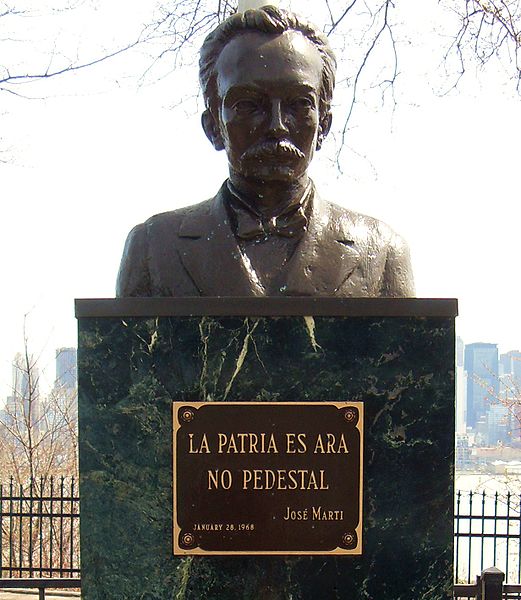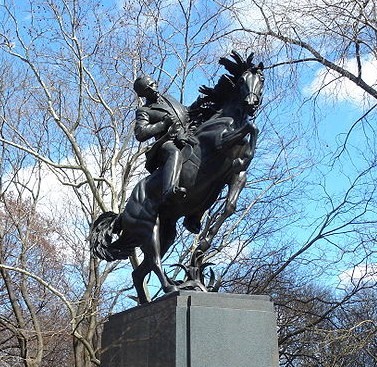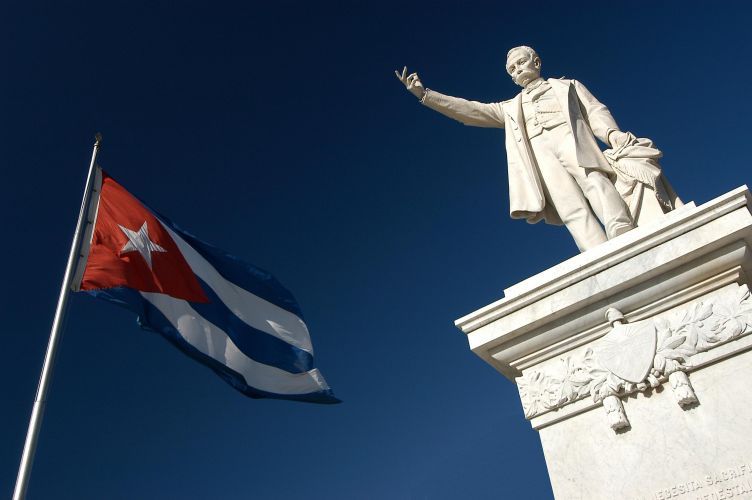<Back to Index>
- Astronomer Johannes Hevelius, 1611
- Author and Cuban Revolutionary José Julián Martí Pérez, 1853
- 2nd Prime Minister of Canada Alexander Mackenzie, 1822
PAGE SPONSOR
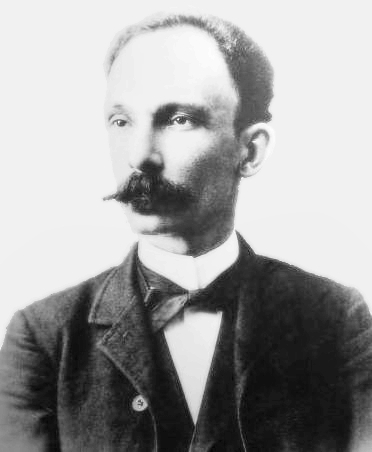
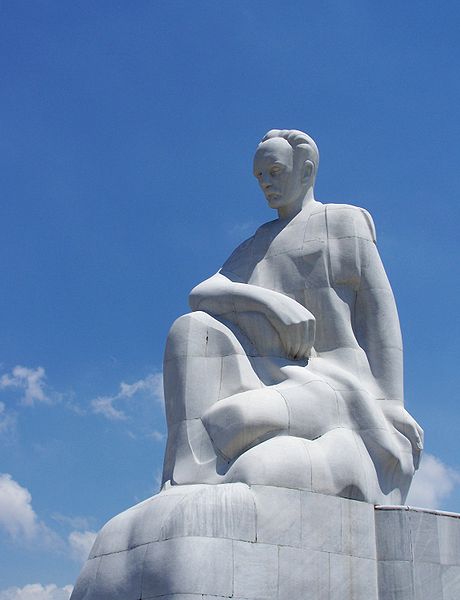
José Julián Martí Pérez (January 28, 1853 – May 19, 1895) was a Cuban national hero and an important figure in Latin American literature. In his short life he was a poet, an essayist, a journalist, a revolutionary philosopher, a translator, a professor, a publisher, and a political theorist. Through his writings and political activity, he became a symbol for Cuba's bid for independence against Spain in the 19th century, and is referred to as the "Apostle of Cuban Independence." He also fought against the threat of United States expansionismin to Cuba. From adolescence, he dedicated his life to the promotion of liberty, political independence for Cuba and intellectual independence for all Spanish Americans; his murder was used as a cry for Cuban independence from Spain by both the Cuban revolutionaries and those Cubans previously reluctant to start a revolt.
Born in Havana, Martí began his political activism at a young age. He would travel extensively in Spain, Latin America, and the United States raising awareness and support for the cause of Cuban independence. His unification of the Cuban émigré community, particularly in Florida, was crucial to the success of the Cuban War of Independence against Spain. He was a key figure in the planning and execution of this war, as well as the designer of the Cuban Revolutionary Party and its ideology. He died in military action on May 19, 1895. Martí is considered one of the great turn-of-the-century Latin American intellectuals. His written works consist of a series of poems, essays, letters, lectures, a novel, and even a children's magazine. He wrote for numerous Latin American and American newspapers; he also founded a number of newspapers himself. His newspaper Patria was a key instrument in his campaign for Cuban independence. After his death, one of his poems from the book, "Versos Sencillos" (Simple Verses) was adapted to the song, "Guantanamera," which has become the definitive patriotic song of Cuba. The concepts of freedom, liberty, and democracy are prominent themes in all of his works, which were influential on the Nicaraguan poet, Rubén Darío and the Chilean poet, Gabriela Mistral.
José Julián Martí Pérez was born on January 28, 1853, in Havana, at 41 Paula St., to a Spanish Valencian father, Mariano Martí Navarro, and Leonor Pérez Cabrera, a native of the Canary Islands.
Martí was the elder brother to seven sisters: Leonor, Mariana,
Maria de Carmen, Maria de Pilar, Rita Amelia, Antonia and Dolores. He
was baptized on February 12 in Santo Ángel Custodio church. When
he was four, his family moved from Cuba to Valencia,
Spain, but two years later they returned to the island where they
enrolled José at a local public school, in the Santa Clara
neighborhood where his father worked as a prison guard. In
1865, he enrolled in the Escuela de Instrucción Primaria
Superior Municipal de Varones that was headed by Rafael María de
Mendive. Mendive was influential in the development of Martí's
political philosophies. Also instrumental in his development of a
social and political conscience was his best friend Fermín
Valdés Domínguez, the son of a wealthy slave-owning
family. In April the same year, after hearing the news of Abraham Lincoln's
assassination, Martí and other young students expressed their
pain — through group mourning — for the death of a man who had decreed the
abolition of slavery in a neighboring country. In 1866, Martí
entered the Instituto de Segunda Ensañanza where Mendive
financed his studies.
Martí
signed up at the Escuela Professional de Pintura y Escultura de La
Habana (Professional School for Painting and Sculpture of Havana) in
September 1867, known as San Alejandro, to take drawing classes. He
hoped to flourish in this area, but did not find commercial success. In
1867, he also entered the school of San Pablo, established and managed
by Mendive, where he enrolled for the second and third years of his
bachelor's degree, and assisted Mendive with the school's
administrative tasks. In April 1868, his poem dedicated to Mendive's
wife, A Micaela. En la muerte de Miguel Ángel appeared in Guanabacoa's newspaper El Álbum. When the Ten Years' War broke
out in Cuba in 1868, clubs of supporters for the Cuban nationalist
cause formed all over Cuba, and José and his friend
Fermín joined them. Martí had a precocious desire for the
independence and freedom of Cuba. He started writing poems about this
vision, while, at the same time, trying to do something to achieve this
dream. In 1869, he published his first political writings in the only
edition of the newspaper El Diablo Cojuelo, published by Fermín Valdés Domínguez. That same year he published "Abdala", a patriotic drama in verse form in the one-volume La Patria Libre newspaper, which he published himself. "Abdala" is about a fictional country called Nubia which struggles for liberation. His
famous sonnet "10 de octubre", later to become one of his most famous
poems, was also written during that year, and was published later in
his school newspaper. In
March of that year, colonial authorities shut down the school,
interrupting Martí's studies. He came to resent Spanish rule of
his homeland at a young age; likewise, he developed a hatred of slavery, which was still practiced in Cuba. On 21 October 1869, aged 16, he was arrested and incarcerated in the national jail, following an accusation of treason and
bribery from the Spanish government upon the discovery of a
"reproving" letter, which Martí and Fermín had written to
a friend when he joined the Spanish army. More
than four months later, Martí confessed to the charges and was
condemned to six years in prison. His mother tried to free her son (who
at 16 was still a minor) by writing letters to the government; his
father went to a lawyer friend for legal support, but all efforts
failed. Eventually Martí fell ill; his legs were severely
lacerated by the chains that bound him. As a result, he was transferred
to another part of Cuba known as Isla de Pinos instead of further imprisonment. Following that, the Spanish authorities decided to repatriate him to Spain. In
Spain, Martí, who was 18 at the time, was allowed to continue
his studies with the hopes that studying in Spain would renew his
loyalty to Spain. In January 1871, Martí embarked on the steam ship Guipuzcoa,
which took him from Havana to Cadiz. He settled in Madrid in a
guesthouse in Desengaño St. # 10. Arriving at the capital he
contacted fellow Cuban Carlos Sauvalle, who had been deported to Spain
a year before Martí and whose house served as a center of
reunions for Cubans in exile. On March 24, Cadiz’s newspaper La Soberania Nacional,
published Martí's article “Castillo” in which he recalled the
sufferings of a friend he met in prison. This article would be
reprinted in Sevilla’s La Cuestion Cubana and New York’s La Republica.
At this time, Martí registered himself as a member of
independent studies in the law faculty of the Central University of
Madrid. While
studying here, Martí openly participated in discourse on the
Cuban issue, debating through the Spanish press and circulating
documents protesting Spanish activities in Cuba. Martí's maltreatment at the hands of the Spaniards and consequent deportation to Spain in 1871 inspired a tract, Political Imprisonment in Cuba,
published in July. This pamphlet's purpose was to move the Spanish
public to do something about its government's brutalities in Cuba and
promoted the issue of Cuban independence. In September, from the pages of El Jurado Federal, Marti and Sauvalle accused the newspaper La Prensa of having calumniated the Cuban residents in Madrid. During his stay in Madrid, Marti frequented the Ateneo and the National Library, the Café de los Artistas, and the British, Swiss and Iberian breweries. In November he became sick and had an operation, paid for by Sauvalle. On
the 27 of November 1871, eight medical students, who had been accused
(without evidence) of the desecration of a Spanish grave, were executed
in Havana. In June 1872, Fermín Valdés was arrested because of the November 27 incident.
His six years of jail were pardoned and he was exiled to Spain where he
reunited with Martí. On November 27, 1872, the printed matter Dia 27 de Noviembre de 1871 (27
November 1871) written by Martí and signed by Fermín
Valdés Domínguez, and Pedro J. de la Torre circulated in
Madrid. A group of Cubans held a funeral in the Caballero de Gracia
church, the first anniversary of the medical students’ execution. In 1873, Martí's “A mis Hermanos Muertos el 27 de Noviembre” was
published by Fermín Valdés. In February, for the first
time, the Cuban flag appeared in Madrid, hanging from Martí’s
balcony in Concepción Jerónima, where he lived for a few
years. In the same month, the Proclamation of the First Spanish
Republic by the Cortes on February 11, 1873 reaffirmed Cuba as
inseparable to Spain, Martí responded with an essay, The Spanish Republic and the Cuban Revolution,
and sent it to the Prime Minister, pointing out that this new freely
elected body of deputies that had proclaimed a republic based on
democracy had been hypocritical not to grant Cuba its freedom. He
sent examples of his work to Nestor Ponce de Leon, a member of the
Junta Central Revolucionaria de Nueva York (Central revolutionary
committee of New York), to whom he would express his will to
collaborate on the fight for the independence of Cuba. In
May, he moved to Zaragoza, accompanied by Fermín Valdés
to continue his studies in law at the Universidad Literaria. The
newspaper La Cuestión Cubana of Sevilla, published numerous articles from Martí. In
June 1874, Marti graduated with a degree in Civil Rights and Canonical
Law. In August he signed up as an external student at the Facultad de Filosofia y Letras de Zaragoza,
where he finished his degree by October. In November he returned to
Madrid and then left to Paris. There he met Auguste Vacquerie, a poet,
and Victor Hugo. In December 1874 he embarked from Le Havre for Mexico. Prevented from returning to Cuba, Martí went instead to Mexico and
Guatemala. During these travels, he taught and wrote, advocating continually for Cuba's independence. In 1875, Martí lived on Calle Moneda in Mexico City near the Zócalo, a prestigious address of the times. One floor above him lived Manuel Mercado, Secretary of the Distrito Federal, who would become one of Martí’s best friends. On March 2, 1875, he published his first article for Vicente Villada's Revista Universal,
a broadsheet discussing politics, literature, and general business
commerce. On March 12, his Spanish translation of Victor Hugo's Mes Fils (1874) began serialization in Revista Universal. Martí then joined the editorial staff, editing the Boletín section
of the publication. In these writings he expressed his opinions about
current events in Mexico. On May 27, in the newspaper Revista Universal, he responded to the anti Cuban independence arguments in the Mexican newspaper La Colonia Española. In December, Sociedad Gorostiza (Gorostiza Society), a group of writers and artists, accepted Martí as a member, where he met his future wife, Carmen Zayas Bazán during his frequent visits to her Cuban father’s house to meet with the Gorostiza group. On January 1, 1876, in Oaxaca, elements contrary to Sebastián Lerdo de Tejada's government led by Gen. Porfirio Díaz proclaimed the Plan de Tuxtepec,
thence instigating a bloody civil war. Martí and fellow Mexican
colleagues established the Sociedad Alarcón, composed of
dramatists, actors, and critics. At this point, Martí began
collaboration with the newspaper El Socialista as
leader of the Gran Círculo Obrero (Great Labour Circle)
organization of liberals and reformists who supported Lerdo de Tejada.
In March, the newspaper proposed a series of candidates as delegates,
including Martí, to the first Congreso Obrero, or congress of
the workers. On June 4, La Sociedad Esperanza de Empleados (Employees'
Hope Society) designated Martí as delegate to the Congreso
Obrero. On December 7, Martí published his article Alea Jacta Est in the newspaper El Federalista,
bitterly criticizing the Porfiristas' armed assault upon the
constitutional government in place. On December 16, he published the
article "Extranjero" (foreigner; abroad), in which he repeated his
denunciation of the Porfiristas and bade farewell to Mexico. In 1877, using his second name and second surname Julián
Pérez as pseudonym, Martí embarked for Havana, hoping to
there arrange moving his family away from Mexico City. He returned to
Mexico, however, entering at the port of Progreso from which, via Isla de Mujeres and Belize, he travelled south to progressive Guatemala City. He took residence in the prosperous suburb of Ciudad Vieja, home of Guatemala's artists and Intelligentsia of the day, on Cuarta
Avenida (fourth avenue), 3 km south of Guatemala City. Commissioned then by the government, he wrote the play Patria y Libertad (Drama Indio) (Country and Liberty (an Indian Drama)). He met personally the president, Justo Rufino Barrios about this project. On April 22, the newspaper El Progreso published his article "Los códigos nuevos" (The
New Laws) pertaining to the then newly enacted Civil Code. On May 29,
he was appointed head of the Department of French, English, Italian and
German Literature, History and Philosophy, on the faculty of philosophy
and arts of the Universidad Nacional.
On July 25, he lectured for the opening evening of the literary society
'Sociedad Literaria El Porvenir', at the Teatro Colón (the
since-renamed Teatro Nacional),
at which function he was appointed vice-president of the Society, and
acquiring the moniker "el doctor torrente," or Doctor Torrent, in view
of his rhetorical style. Martí taught composition classes free
at the academia de niñas de centroamérica girls' academy, among whose students he enthralled young María García Granados, daughter of Guatemalan president Miguel García Granados.
The schoolgirl's crush was unrequited, however, as he went again to
México, where he met Carmen Zayas Bazán and whom he later
married. In 1878, Martí returned to Guatemala and published his book Guatemala,
edited in Mexico. On May 10, socialite María García
Granados died of lung disease; her unrequited love for Martí
branded her, poignantly, as 'la niña de Guatemala, la que se
murió de amor' (the Guatemalan girl who died of love). Following
her death, Martí returned to Cuba. There, he finished signing the Pact of Zanjón which ended the Cuban Ten Years' War, but had no effect on Cuba's status as a colony. During this same journey he married Carmen Zayas Bazán on Havana's Calle Tulipán Street.
In October, his application to practice law in Cuba was refused, and
thence immersed himself in radical efforts, such as for the Comité Revolucionario Cubano de Nueva York (Cuban
Revolutionary Committee of New York). On November 2, 1878 his son
José Francisco, known fondly as "Pepito", was born. After a short time in New York, Martí travelled to Venezuela in 1881 and founded the Revista Venezolana,
or Venezuelan Review. The journal provoked the wrath of Venezuela's
dictator, Antonio Guzmán Blanco, and Martí was forced to
leave for New York. Back in New York Martí joined General Calixto García's
Cuban revolutionary committee, made up of exiled & disheveled
Cubans who wanted independence for Cuba. Here Martí supported
Cuban independence freely. He worked as a newspaper reporter and was
also a correspondent for La Nación of Buenos Aires and for different Central American journals, especially La Opinion Liberal in Mexico City. The article "El ajusticiamiento de Guiteau," an account of President Garfield's murderer's trial, was published in La Opinion Liberal in 1881, and later selected for inclusion in The Library of America's
anthology of American True Crime writing. At the same time,
Martí wrote poems and translated novels to Spanish. He worked
for Appleton and Company and, "on his own, translated and published
Helen Hunt Jackson's Ramona. His repertory of original work included plays, a novel, poetry, a children's magazine, La Edad de Oro, and a newspaper, Patria, which became the official organ of the Cuban Revolutionary party". Also,
he worked very hard by serving as a consul for Uruguay, Argentina, and
Paraguay. Throughout this work, he preached the "freedom of Cuba with
an enthusiasm that swelled the ranks of those eager to strive with him
for it". Within
the revolutionary committee, there was tension between Martí and
his Cuban military compatriots. Martí thought it was of utmost
importance that a military dictatorship not be established in Cuba upon
independence, and suspected Dominican-born General Máximo Gómez of having these very intentions. Martí
knew that the independence of Cuba needed careful planning and would
take time. This is why Martí refused to cooperate with Máximo Gómez and Antonio Maceo Grajales, two Cuban military leaders from the Ten Years' War,
when they wanted to invade immediately in 1884. Martí knew that
it was too early to attempt to win back Cuba, and later events proved
him right. On January 1, 1891, Martí's essay "Nuestra America" was published in New York's Revista Ilustrada, and on the 30th of that month in Mexico's El Partido Liberal.
He actively participated in the Conferencia Monetaria Internacional
(The International Monetary Conference) in New York during that time as
well. On June 30 his wife and son arrived in New York. After a short
time, in which Carmen Zayas Bazán realized that Martí's
dedication to Cuban independence surpassed that of supporting his
family, she returned to Havana with her son on 27 August. Martí
would never see them again. The fact that his wife never shared the
convictions central to his life was an enormous personal tragedy for
Martí. He
turned for solace to Carmen Miyares de Mantilla, a Venezuelan who ran a
boarding house in New York, and he is presumed to be the father of her
daughter María Mantilla, who was in turn the mother of the actor Cesar Romero,
who proudly claimed to be Martí's grandson. In September
Martí became sick again. He intervened in the commemorative acts
of The Independents, causing the Spanish consul in New York to complain
to the Argentine and Uruguayan governments. Consequently, Martí
resigned from the Argentinean, Paraguayan, and Uruguayan consulates. In
October he published his book Versos Sencillos. On the 26 of November, he was invited by the Club Ignacio Agramonte of Tampa, Florida, to a celebration to collect funding for the cause of Cuban independence. There he gave a lecture known as "Con Todos, y para el Bien de Todos". The following night, another lecture, " Los Pinos Nuevos",
was given by Martí in a gathering in honor of the medical
students killed in 1871. In November artist Herman Norman painted a
portrait of José Martí. On January 5, 1892, Martí participated in a reunion of the emigration representatives, in Cayo Hueso, where the Bases del Partido Revolucionario (Basis
of the Cuban Revolutionary Party) was passed. He began the process of
organizing the newly formed party. To raise support and collect funding
for the independence movement, he visited tobacco factories, where he
gave speeches to the workers and united them in the cause. In March
1892 the first edition of the Patria newspaper,
related to the Cuban Revolutionary Party, was published, funded and
directed by Martí. On April 8, he was chosen delegate of the
Cuban Revolutionary Party by the Cayo Hueso Club in Tampa and New York.
From July to September 1892 he traveled through Florida, Washington,
Philadelphia, Haiti, the Dominican Republic and Jamaica on an
organization mission among the exiled Cubans. On this mission,
Martí made numerous speeches and visited various tobacco
factories. On December 16 he was poisoned in Tampa. In
1893, Marti traveled through the United States, Central America and the
West Indies, visiting different Cuban clubs. His visits were received
with a growing enthusiasm and raised badly needed funds for the
revolutionary cause. On May 24 he met Rubén Darío, the Nicaraguan poet in a theatre act in Hardman Hall, New Mexico. On June 3 he had an interview with Máximo Gómez in Montecristi, Dominican Republic, where they planned the uprising. In July he met with General Antonio Maceo Grajales in San Jose, Costa Rica. In 1894 he continued traveling for propagation and organizing the revolutionary movement. On January 27 he published "A Cuba!" in the newspaper Patria where
he denounced collusion between the Spanish and American interests. In
July he visited the president of the Mexican Republic, Porfirio Díaz, and travelled to Veracruz. In August he prepared and arranged the armed expedition that would begin the Cuban revolution. January 12, 1895, the North American authorities stopped the steamship Lagonda and two other suspicious ships, Amadis, and Baracoa at
the Fernandina port in Florida, confiscating weapons and ruining Plan
de Fernandina (Fernandina Plan). On January 29, Martí drew up
the order of the uprising, signing it with general Jose Maria Rodriguez
and Enrique Collazo. They decided to move to Montecristi, to join Máximo Gómez and to plan out the uprising. Martí
had persuaded Gómez to lead an expedition into Cuba. The
expedition finally took place on February 24, 1895. A month later,
Martí and Gómez declared the Manifesto de Montecristi, an
"exposition of the purposes and principles of the Cuban revolution".
Before leaving for Cuba, Martí wrote his "literary will" on
April 1, 1895, leaving his personal papers and manuscripts to Gonzalo de Quesada,
with instructions for editing. Knowing that the majority of his writing
in newspapers in Honduras, Uruguay, and Chile would dissipate,
Martí instructed Quesada to arrange his papers in volumes. The
volumes were to be arranged in the following way: volumes one and two,
North Americas; volume three, Hispanic Americas; volume four, North
American Scenes; volume five, Books about the Americas (this included
both North and South America); volume six, Literature, education and
painting. Another volume included his poetry. The
expedition, composed of Martí, Gómez, Ángel
Guerra, Francisco Borreo, Cesar Salas and Marcos del Rosario, left
Montecristi for Cuba on April 1, 1895. Despite
delays and desertion by some members, they got to Cuba. They landed at
Playitas, near Maisi Cape, Cuba, on April 11. Once there, they made
contact with the Cuban rebels, who were headed by the Maceo brothers,
and started fighting against Spanish troops. By May 13, the expedition
reached Dos Rios. On May 19, Gomez faced Ximenez de Sandoval's troops
and ordered Martí to stay rearguard, but Martí separated
from the bulk of the Cuban forces, and entered the Spanish line. José Martí was killed in battle against Spanish troops at the Battle of Dos Ríos, near the confluence of the rivers Contramaestre and Cauto,
on May 19, 1895. Gómez had recognized that the Spaniards had a
strong position between palm trees, so he ordered his men to disengage.
Martí was alone and seeing a young courier ride by he said:
"Joven, a la carga" meaning: "Young man, let's charge!" This was around
midday, and he was, as always, dressed in a black jacket, riding a
white horse, which made him an easy target for the Spanish. The young
trooper, Angel de la Guardia, lost his horse and returned to report the
loss. The Spanish took possession of the body, buried it close by, then
exhumed the body upon realization of its identity. They are said not to
have burned him because they were scared that the ashes would get into
their throats and asphyxiate them. He is buried in Cementerio Santa
Efigenia in Santiago de Cuba.
Many have argued that Maceo and others had always spurned Martí
for never participating in combat, which may have compelled
Martí to that ill-fated suicidal two-man charge. Some of his Versos sencillos bore
premonition: "No me entierren en lo oscuro/ A morir como un traidor/ Yo
soy bueno y como bueno/ Moriré de cara al sol." ("Do not bury me
in darkness / to die like a traitor / I am good, and as a good man / I
will die facing the sun.") The
death of Marti was a blow to the "aspirations of the Cuban rebels,
inside and outside of the island, but the fighting continued with
alternating successes and failures until the entry of the United States
into the war in 1898".
